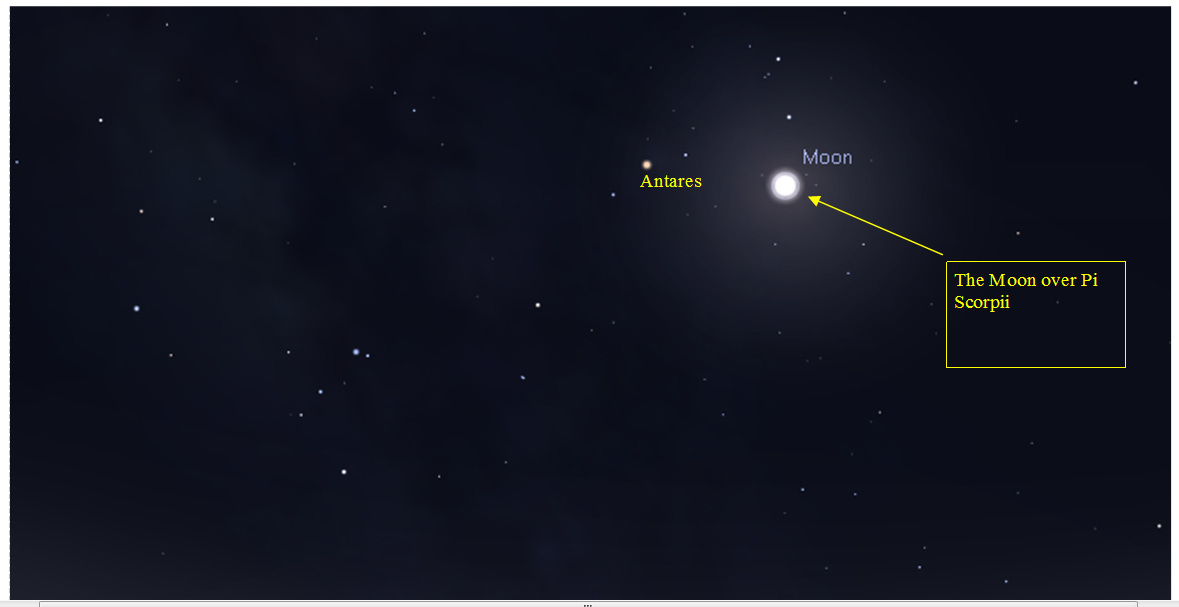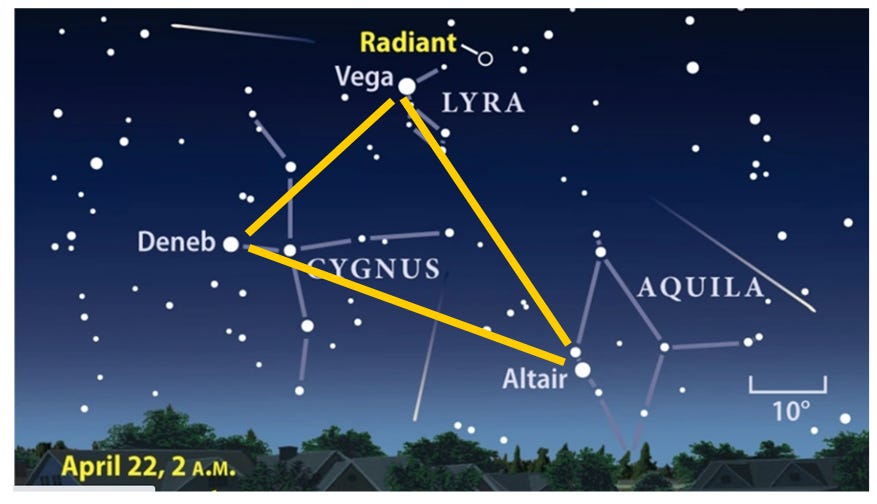TGT #25G - The Moon Dances with Four Worlds - Lyrids Peak in Reasonably Dark Skies - Cosmic Jewelry
TGT 4/16/25: Astronomy in Everyday Life (Rich Person's Edition)--Astro Jewelry for Not-the-Masses; Sky Gazing Calendar--Four Conjunctions of Moon and Planets; The Year's First* Meteor Shower.
Cover Photo - The Summer Triangle and Radiant of the Lyrids
In This Issue:
Cover Photo — The Summer Triangle and the Radiant of the Lyrids
Welcome to Issue #25G!
Sky Planning Calendar —
* Moon-Gazing - Four Planet and Moon Conjunctions
* Observing—Plan-et - Lyrids Provide a Decent Show
Deeper Looks - The Lyrid Meteor Shower
Astronomy in Everyday Life - Cosmic Jewelry
Welcome to The Galactic Times Newsletter-Inbox Magazine #25G!
Greetings, Galactic Timers!
The exciting times this fortnight is in the pre-dawn and morning twilight hours. As noted in both the Moon-Gazing and Observing Plan-et! sub-columns, the Moon passes four of the five planets quickly and relatively clearly without obscuring the planets themselves. Three are in the dawn sky, Mercury and Venus and Saturn. Jupiter gets its chance at month-end but Mars has to wait.
Then, too, around the 22nd, plus or minus a night for good measure, the Lyrid meteor shower puts on the year’s first traditional ‘major’ shower, if you count 20 meteors per hour as major. But most of the night is moonless and the meteors come from a point nearly overhead by dawn so you’ll get the max Max this shower would produce. See the Deeper Looks column.
Finally, for those with big budgets (for travel or fine things), the American Museum of Natural History, home of the famous Hayden Planetarium in New York City, is running an exhibit of expensive jewelry all designed to look like cosmic objects, or theories of same. Samples are in the Astronomy in Everyday Life column. If you still don’t want to pledge to a subscription or sign up on our Patreon, I’ll take the watch…..
- - - - -
Do you want to get these issues right away in your mail inbox? Then subscribe. We don’t put the latest issue up on the Substack webpage until a week later.
* Not a Subscriber? Want to read this off the Web? Please hit the link..right… below:
Enjoy!
Publisher — Dr. Larry Krumenaker Email: newsletter@thegalactictimes.com
Sky Planning Calendar
Moon-Gazing
Moon passages by a star, planet or deep sky object are a good way to find a planet or other object if you’ve never located it before.
April 16 That bright star to the left of the dawn Moon is Antares. In the Australian dusk, the Heart of the Scorpion star will be behind the Moon. Additionally, one to two hours before dawn in the Western North American area, the Moon passes over the bottom of the three Scorpion-head stars, Pi Scorpii.

April 20 Last Quarter Moon.
April 24 Not so much for North Americans, more for Europeans, Venus will be 2-degrees North of the Moon (to the planet’s right) and so will be Saturn. Closest approach happens in N.A. before they rise in dawn hours but you still get a nice photographic scenario even if not at their closest approaches (see above charts). Then, tomorrow….
April 25 ….Mercury is four-degrees from the Moon, but again, before they rise into North American skies. For those observers, find the Moon to the left of Saturn and upper right of Mercury. Tomorrow …
April 26 …Mercury is to the Moon’s right.
April 27 The Moon is at Perigee, its closest orbital point to Earth. It is also New Moon. Makes that a Super-New Moon — the largest invisible Moon possible.
April 29 Find the Moon just a half-degree—-its own diameter—from the Pleiades star cluster, about midnight, before this day’s dawn.
April 30 Jupiter completes the four lunar conjunctions with planets in this two-week period. It will be 5-degrees South (below) the crescent Moon. See below.
Observing---Plan-et
==A Fortnight of Four Planet+Moon Conjunctions==
Mercury reaches its Greatest Elongation, West of the Sun in the dawn on the 20th, one day before its Greatest Brilliance Day; the differences between the two dates will be trivial. It is very bright and 27-degrees from Sol but because of low altitude above the horizon, better from Southern Hemisphere observers than Northern. Still it rises on those dates about an hour before Sunrise. It can be most easiest found in the dawn of the 25th near the Moon.
Venus has zoomed back into prominence, in brightness and in distance away from the Sun, but not in ease of appearance. That 40+-degrees distance was nearly vertical a month or two ago in the evening but, like Mercury, it now has a large horizontal component to that distance. It, too, reaches a greatest brilliance this time-frame, on the 27th. On the next dawn it is at its closest approach, four degrees, from Saturn. Should help you find the much fainter, lost in the glow, planet. It rises at the start of morning twilight but takes into June to be seen in a truly dark sky.
Mars follows Jupiter down three hours after the latter planet so there is about a two-hour planet-free time in the night, between Martian setting and Venusian rising. We two worlds are rapidly moving away from each other AND Mars reaches its aphelion, making the Red World fainter than usual and telescopically now bland.
Jupiter, meanwhile, sets before midnight Daylight Saving Time, less than two hours after the end of evening twilight. It is your best evening planetary body—brightest, biggest in optics. But not for long, and it is not in the morning sky for pre-dawn observers. The Moon passes by it on the 30th.
Saturn hangs out with Venus and Mercury and the Moon for a couple of days around the 24th. Mercury will drop off but Venus and Saturn stick together into early May.
Deeper Looks - The Lyrid Meteor Shower
Earth has been in a bit of a vacation from cometary debris, i.e. meteor showers, but we get the traditional first-shower-of-the-year* Lyrids peaking on the 22nd.
[See Cover Photo for a map looking East at 2AM. The whole field is higher and to the west — right—nearer moonrise and start of morning twilight. The radiant is just barely outside of Hercules constellation but near the brightest of the three Summer Triangle stars, Vega, in Lyra.]
It only lasts 1.3 days, roughly a half a day (IN the daytime) on each side of maximum, and not much better than 20 meteors in a hour, that is when it is near the overhead point. Like most showers, it has that max just before dawn begins, in this case, an hour before dawn, but the Lyrids, seeming to come from the constellation of Lyra the Harp (or Lyre), is near enough to the zenith to max out that Maximum. If your weather is warm enough, it is a good way to get someone started into meteor observation. Additionally, on the peak morning, the fat Gibbous Moon doesn’t rise until about 3:30 AM so most of the night will be moonless and dark.
*While technically the January 3rd Quadrantids do come after New Year’s, it is more like a shower that couldn’t squeeze into the December of the previous year. We then afterwards, forgetting about truly minor showers, have a shower-less gap until April, when we can say it really is a true current-year shower. IMO.
Astronomy in Everyday Life
Cosmic Jewelry
These popped up as an advertisement in my digital New York Times the other day. Cosmic jewelry with likenesses of stars, Sun and Moon have been made since homo sapiens figured out how to smelt metals and mold them to their liking.
These are not just found in your local jewelry counter or store but artwork jewelry in an exhibit —Cosmic Splendor: Jewelry from the Collections of Van Cleef & Arpels — through next New Years at the American Museum of Natural History in New York City. Several truly got my interest (if not within my credit card limit):
Above are two clips that are spiral galaxies. In many spirals the arms are easily observed with emission nebulae glowing in red hydrogen light, and with not quite as bright white star clusters; here they are artistically licensed to be equally obvious. But at least it is somewhat astronomically correct.
This Moon pendant doesn’t show the near or far side of the Moon accurately but at least it shows the Moon as not the smooth white surface it appears to be with the naked eye. I do wonder, thought, what the red jewel is marking in the circular Mare sea? Is this a map of the early Moon when the maria were first made and that’s an asteroid exploding at the lunar surface?
Lastly, a watch face that would make Aristotle proud! A heliocentric solar system, from Sun to Mercury out to Saturn (sans rings, though) and a comet for good measure. Why Aristotle and not Copernicus? Both had the heliocentric hypothesis but Aristotle did it first.







